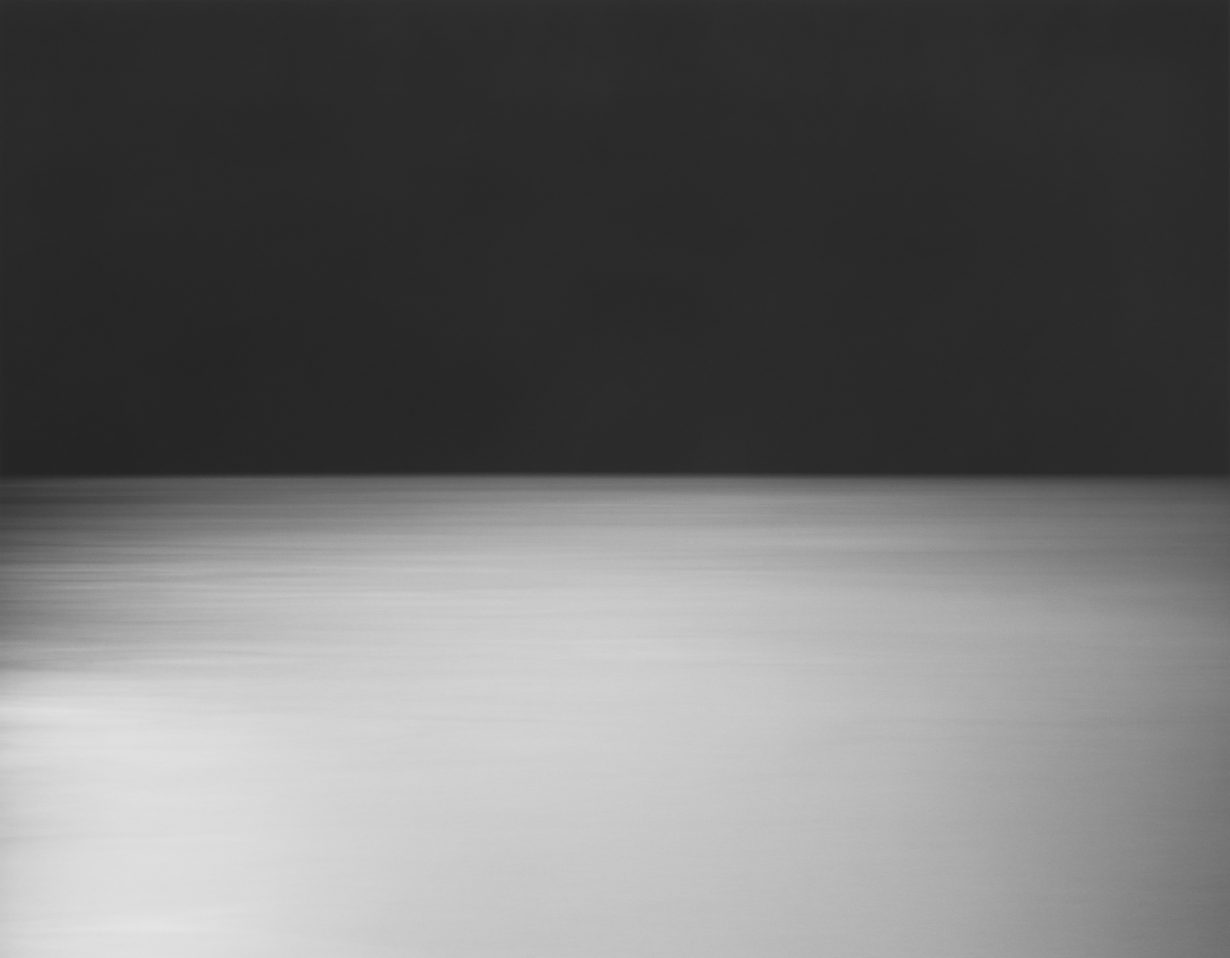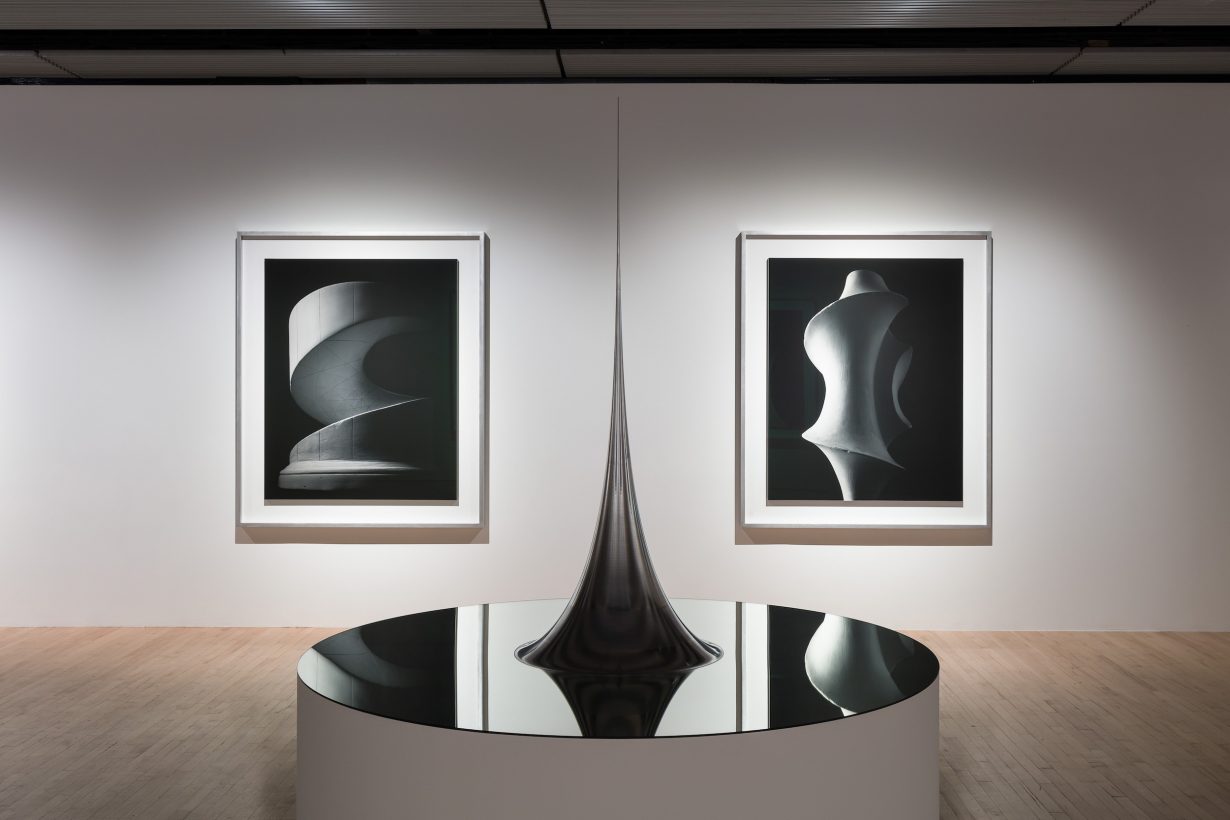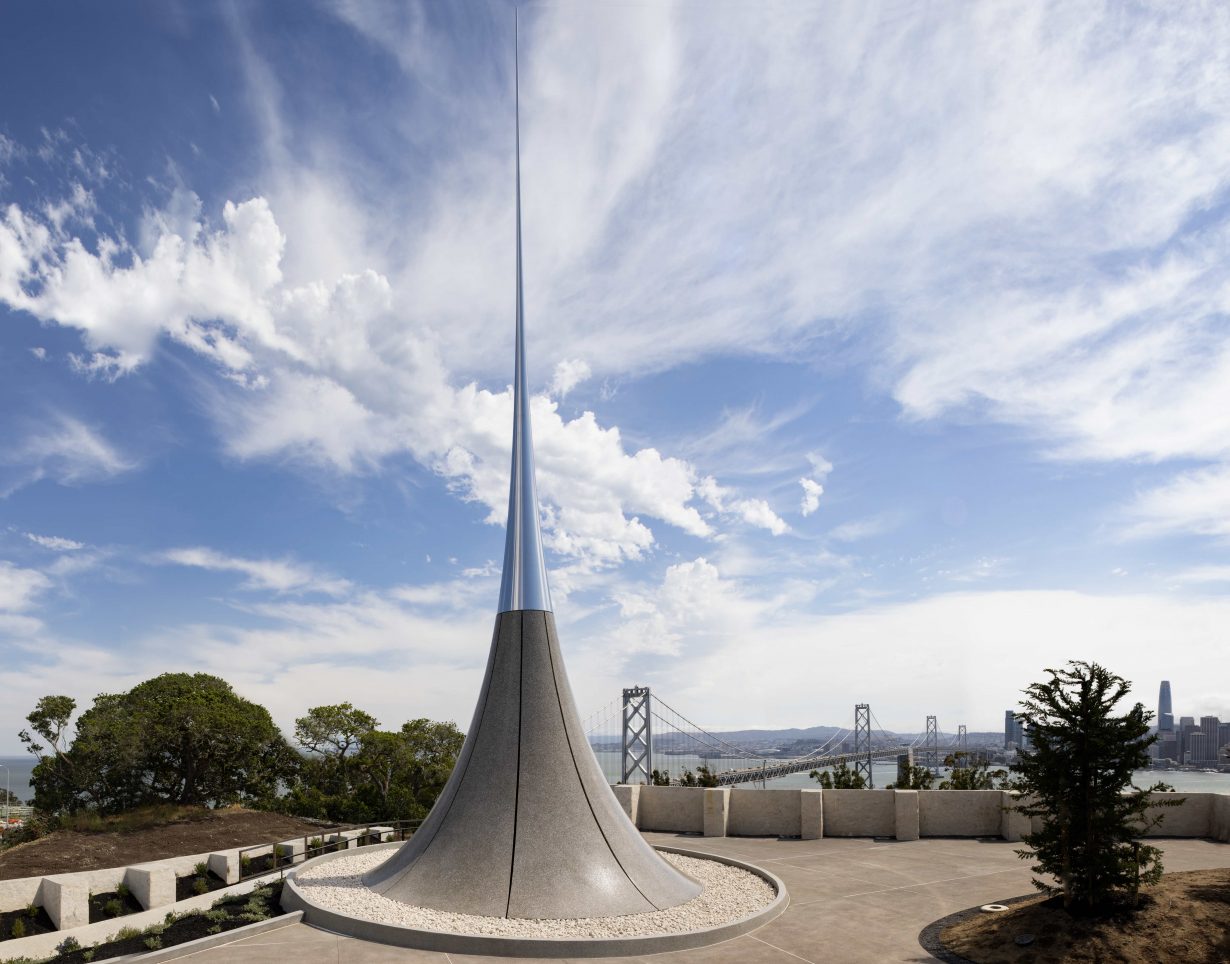“I think the end is coming pretty soon”
Hiroshi Sugimoto is best known for his ethereal black-and-white photography, beginning with the series Diorama (1974), for which he photographed the uncanny displays of animals and prehistoric human beings showcased in New York’s American Museum of Natural History. Followed by the haunting series Seascapes (1980–), with its minimalist ocean horizons and Theaters (1976–), which consists of shots of cinema screens in empty theatres illuminated bright white through single exposures lasting the duration of projected films. Sugimoto’s choice in subject matter, use of large-format antique cameras and subsequent hand-development of black-and-white prints offer a photographic meditation on nature, time, history and human consciousness. The result lends his work a place- and timelessness; each series a collection of transient moments captured in permanence.
In more recent decades, Sugimoto has ventured into sculpture, architecture and the performing arts. His foray into architecture in 1996 resulted in the restoration of Naoshima’s medieval Goō Shinto Shrine: inspired by elements of animist worship (which often focuses on sites of natural force – a waterfall, a tree, a large boulder), Sugimoto also installed a glass staircase to allow access between the main sanctuary and an underground rock chamber; visitors can exit from the latter via a concrete-walled tunnel that opens out onto a mountainside view of the sea. Not a licensed architect himself, Sugimoto partnered with architect Tomoyuki Sakakida in 2008 to found New Material Research Laboratory that designed the monumental Enoura Observatory in Odawara. The spectacular observatory overlooks Kanagawa prefecture’s Sagami Bay and contains a gallery space, a Noh theatre stage, tea ceremony room and gardens. It is part of Sugimoto’s Odawara Art Foundation, which he founded in 2009 with the aim of promoting Japanese history through classical and avant-garde theatre arts. From the 2000s, Sugimoto began to create site-specific sculptures inspired by mathematical concepts. The resulting works have been installed at different locations around the world, from Concept of Moss (2009) at Benesse House, Naoshima, to Confession of Zero (2014) at Castello di Ama, Siena.
Sugimoto’s photographic work is the focus of his largest exhibition to date and currently on view at London’s Hayward Gallery. Now seventy-five and as prolific as ever, Sugimoto took time in his Tokyo studio to reflect on his life of photography, philosophy and architecture, and the apocalyptic visions of the near future that are informing the legacy he hopes to leave behind.

Are You Experienced?
ArtReview: After spending most of your professional life living in New York City, you recently returned to live in Tokyo. Why?
Hiroshi Sugimoto: New York is no longer so attractive to me because it’s been changed. Many of my friends have passed away or retired. Manhattan is not a place for young artists to play around, everything is so costly. I was in New York from 1974 and artists were mainly based in SoHo and Manhattan. There was an art community. Now there are only the galleries and rich people. The art market keeps getting bigger and bigger. And it keeps kicking artists out of the city. Art became a commodity. People buy art for future profit. Citibank approved art as an asset and will loan money using art as the collateral.
AR: Do you find any conflict there for yourself?
HS: Well, I only started making money at fifty years old. Before that I was giri-giri [Japanese for ‘just barely’] – barely even able to buy my film. I asked myself: what should I do with all this money? So I decided to reinvest all the profit back into my art. I try not to keep cash. That’s the idea behind the Odawara Foundation. I told my kids, you aren’t getting cash, but you will inherit this valuable foundation that you may run in the future.
AR: Did your lengthy experience living in America change your sense of identity?
HS: I was in Japan until I was twenty-two years old, and my main area of study was Marxist economics. It was the late 1960s and at that time socialism and communism were the study of the intelligentsia. To learn Marxist economics you had to learn German philosophy – Hegel, Feuerbach and Kant – so that was my basic study. In Japan I tried to catch up to European and American thinking.
But when I moved to California there was a hippie movement and everyone was asking me if I was ‘enlightened’ or not. So I had to quickly change course. Reading D.T. Suzuki’s book [Essays in Zen Buddhism, 1927] was really helpful with that. When people would ask if I was enlightened I would say, “Of course I am”.
AR: So you’re kind of playacting for people or leaning into Japanese stereotypes to give them what they want?
HS: For my art, I’m just trying to give the most artlike art I can make, to satisfy people. I always say you can write anything you like about art. Nothing is wrong, which means any kind of criticism, I can accept it. It may not be true, but it’s also not necessarily wrong.

Am I Hallucinating?
AR: I recently saw a selection of prints from your Conceptual Form series [2004, photographs of sculptures that visualise mathematical concepts, including zero and infinity] at the Mori Art Museum here in Tokyo. Yet you’ve previously said that you don’t fully subscribe to the Western notion of a rational world. Can you explain what you mean by that?
HS: I was always wondering what this world consists of – the elements. I’m a dreamer. My childhood was spent wondering if this world actually exists or not. It could all be my hallucinogenic vision. I was into building models as a kid, model trains and model ships. To make a model I had to go and see the actual locomotive. And that’s how I started photography, taking photos of those trains.
LH: How old were you when you began to have these existential thoughts? Or to think that the world might not be real?
HS: Elementary school. I was in bed and couldn’t sleep and stared at the wooden ceiling, at the knots in the wood, and they started to move, to expand. I became aware of myself. I had this kind of dreamy imagination. I still have it. I’ve said it before, but the seascape is my first memory. And that happens to be the location for the Odawara Foundation. You could say I decided to buy my memory back, when I bought the site.
AR: Some of the models you photograph, like those based on a Kuen surface, start off as computer renderings that can only be created as an object by a five-armed robotic machine. How do you feel about generative art, machine learning and AI?
HS: I’m kind of scared of it. Once it can do a job better than a human, what can a human do? Particularly in terms of the skills involved in thinking and imagination. If a human can’t do as good of a job as the machine, then what is the point of a human? The brain has to be trained to keep thinking. If you don’t have to think deeply – if you let the computer think for you – then the human brain will have to become something else.
AR: That’s transhumanism, isn’t it? Where humans interface fully with technology. Do you think that’s inevitable?
HS: I’m just glad I’m not going to be living in that future. But the world will end very soon in my estimation. For example, if you compare last year’s global temperature with this year, it’s one or two degrees hotter now – global warming is now global boiling. I think the end is coming pretty soon.

The End Is Nigh
AR: Do you have a sense of impending doom?
HS: I did a show at Palais de Tokyo called Lost Human Genetic Archive [2014], which included 33 stories about the end of the world, narrated by fictional characters. That was meant half-seriously and half-jokingly, but now so many things I thought about are becoming a reality. So I may be able to encounter the end of the world while I’m living.
AR: With your architecture you say you are trying to create structures that will last beyond humanity, but what if nobody is here to see it?
HS: The Odawara Foundation is intended to be present 5,000 years in the future. I’m thinking of how beautiful it can be standing as a ruin. So, the structure dies, the glass is smashed, the cantilevered tip is bending down, but the stone structure remains – same as a pyramid or a Greek temple. Conceptually, if humans are gone, who records history, or the presence of materials, or the world, or the universe? It’s interesting to think about what might happen to human memory once humans no longer exist. Who would own those memories… God or not?
AR: Do you believe in God?
HS: Not in the personalised God. But I believe in some kind of eternal spirituality or some kind of presence of spirit. In the Shinto religion, we believe there are spirits in nature. We have to worship in nature.
But humans separate themselves from nature, then invade it, cut the roots, cut the forest, make flat land and cultivate it, and that becomes ‘civilisation’. Civilisation means braking nature. But in the Shinto belief-system, if you cut the root and cut the forest, you would be punished by nature’s spirits. So in Japan we have had to find a way to cultivate and civilise, while protecting nature as much as possible.

Cultivating Gardeners
AR: I’d like to talk about architecture a bit and the New Material Research Laboratory. For the Enoura Observatory and other projects, you repurpose some rare and salvaged materials – yakusugi [Japanese cedar], ancient stonework, Canadian cypress. Some of these materials are no longer legally obtainable. What’s the intention behind that?
HS: I’ve been able to find some yakusugi from 100 years ago, which is now illegal to cut down. Occasionally a typhoon comes and a beautiful yakusugi tree falls and the government will put it on the market. It’s also a material used in some old wooden buildings. When these are demolished, I’m able to salvage some good parts from the remains.
AR: How do you find these materials? How do you seek them out?
HS: I have a network – like a ninja. I’m one of the few people who pays attention to and has an interest in these materials. There’s a shared interest among us. So I’ll receive a call and someone will say, “I found this beautiful material, will you take this?” Sometimes it’s free, sometimes it comes at a very high price. So, I know all the gardeners in the Kansai region.
AR: You have a spy network of gardeners?
HS: Odawara Foundation happens to have one of the finest collections of precious stones from ancient temples. Todai-ji temple [in Nara] had a huge eighth-century base stone from the pavilion, which we installed last year near the stone stage.
AR: What is it about this era of stonework that fascinates you?
HS: The history of Japan. Especially in the ancient capital of Nara, you can see the quality of the stone that a human chiselled out as a sculpture. Modern people can’t make that. Even by the fifteenth century, stone sculptures get less and less interesting. I think the very primitive method of forming a shape is better. It takes more time, but makes a better shape. It’s that entire history, an architectural history, that I’m collecting.

AR: Are you trying to show that trajectory? We think we’re progressing culturally and technologically, and that we’re going to reach some pinnacle of humanity. But you’re saying –
HS: It’s going slowly downward [laughs]. The peak was the twelfth-century Fujiwara period, I think. I value it as the peak of Japanese production.
AR: Do you hope that New Material Research Laboratory and your architectural works will act as a storehouse of knowledge for future generations to draw from just as you are drawing from that period?
HS: I do. But I expect the next ‘big one’ [earthquake] is coming. When the cities are wiped out, it’ll be nice to rebuild.
AR: An opportunity out of tragedy. Andif you could reshape the world (or Japan),what else would you do?
HS: Well, rural areas and smaller cities are still beautiful. Odawara, for example, is still beautiful. With new technology and communication, people can live far from the city and still work and be in communication. A good thing about COVID-19 is that we saw we could decentralise where we live.
AR: Since you draw so deeply from traditional Japanese culture and present it to Western audiences who may not know much about this history, is there ever a danger of exoticising it?
HS: There is a kind of clichéd image or premade image of Japan that I’m trying to sometimes use. As a Japanese person living outside of Japan for more than 50 years, it’s a kind of tactic and technique. I have to explain Japanese culture to American and European people, but I also have to teach Japanese people to more seriously consider: what is the true spirit of the Japanese? Even then, I have to teach myself who I am as a Japanese. But I am not American for sure.
Free to Be
AR: Can you tell us about your retrospective at the Hayward?
HS: Well, at first I told them let’s do it after my life is over. A retrospective usually honours the entirety of the artist’s work, so they have to be dead for it to be complete.
AR: You make it sound like a living funeral.
HS: No, it’s called a ‘midcareer’ retrospective [laughs]. A new phrase. So I accepted. It was unusual as they requested only my photography. I do many things, architecture, sculpture, theatre, but they really wanted to concentrate on my career as a photographer. I think it’s a good idea.
AR: Well, all of your work overlaps, doesn’t it?
HS: Yes, it’s all interconnected anyway. But they didn’t include my most recent photographs, they drew a line at work made up till about five or six years ago. They had to draw a line somewhere. Maybe Optiks [2018] is the most recent work included.
AR: You are now seventy-five and still prolific. When he was seventy-seven, Akira Kurosawa wrote a letter to Ingmar Bergman describing the brilliance of the artist Tessai Tomioka’s work after the latter turned eighty. He believed artists can produce their purest works during their ‘second babyhood’, as he called it. Do you feel any truth in that?
HS: Yes, I do feel I am going back to the ‘second babyhood’. I feel more free than when I was middle-aged.
AR: How so?
HS: I’m freed from sexual ambition. That gives me more free time. I don’t have to think about sex. When I was a baby, I didn’t think about sex, so I was more free – my mind was using its full imagination. After my teens 90 percent of my mind was focused on sex, and only 10 percent played with imagination.
Hiroshi Sugimoto is on view at the Hayward Gallery, London, through 7 January
Lance Henderstein is a writer and photographer based in Japan
